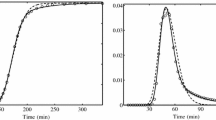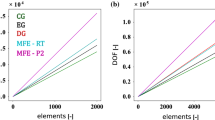Abstract
Over recent decades, fluid flows in porous media have been studied both experimentally and theoretically. Different numerical methods were used for obtaining the solutions of some transport phenomena in porous media, e.g. the finite-difference method (FDM), finite element method (FEM), finite volume method (FVM), as well as the boundary element method (BEM). The main comparative advantage of the BEM, the application of which requires the given partial differential equation to be mathematically transformed into the equivalent integral equation representation, which is later to be discretized over the discrete approximative methods is demonstrated in cases where this procedure results in boundary integral equations only, see Brebbia [2]. This turns out to be possible only for potential problems, e.g. inviscid fluid flow, heat conduction, etc. In general, the procedure results in boundary-domain integral equations and therefore several techniques were developed to extend the classical BEM, see Brebbia et al. [3]. The dual reciprocity boundary element method (DRBEM) represents one of the possibilities for transforming the domain integrals into a finite series of boundary integrals. The key point of the DRBEM is the approximation of the field in the domain by a set of global approximation functions and the subsequent representation of the domain integrals of these global functions by boundary integrals.
Access this chapter
Tax calculation will be finalised at checkout
Purchases are for personal use only
Preview
Unable to display preview. Download preview PDF.
Similar content being viewed by others
References
Bear, J. and Bachmat, Y. (1991). Introduction to modeling of transport phenomena in porous media. Kluwer, Dordrecht.
Brebbia, C. A. (1978). The boundary element method for engineers. Pentech Press, London.
Brebbia, C. A., Telles, J. C. F. and Wrobel, L. C. (1984). Boundary element methods theory and applications. Springer-Verlag, New York.
Hribersek, M. and Skerget, L. (1996). Iterative methods in solving Navier-Stokes equations by the boundary element method. Int. J. Numer. Meth. Eng., 39, 115–39.
Jecl, R., Skerget, L. and Petresin, E. (2001). Boundary domain integral method for transport phenomena in porous media. Int. J. Numer. Meth. Fluids, 35, 39–54.
Kaviany, M. (1995). Principles of heat transfer in porous media. Springer, New York.
Nield, D. A. (2002). Modelling fluid flow in saturated porous media and at interfaces. In Transport phenomena in porous media II (ed. D. B. Ingham and I. Pop), pp. 1-19. Pergamon, Oxford.
Nield, D. A. and Bejan, A. (1999). Convection in porous media (2nd edn). Springer, New York.
Skerget, L., Alujevié, A., Brebbia, C. A. and Kuhn, G. (1989). Natural and forced convection simulation using the velocity-vorticity approach. Topics in Boundary Element Res., 5, 49–86.
Skerget, L. and Jecl, R. (2001). Boundary element method for transport phenomena in porous media. In Transport phenomena in porous media II (ed. D. B. Ingham and I. Pop), pp. 20-53. Pergamon, Oxford.
Skerget, L., Hribersek, M. and Kuhn, G. (1999). Computational fluid dynamics by boundary-domain integral method. Int. J. Numer. Meth. Eng., 46, 1291–311.
Author information
Authors and Affiliations
Editor information
Editors and Affiliations
Rights and permissions
Copyright information
© 2004 Springer Science+Business Media Dordrecht
About this paper
Cite this paper
Škerget, L., Jecl, R. (2004). Compressible Fluid Dynamics in Porous Media by the Boundary Element Method. In: Ingham, D.B., Bejan, A., Mamut, E., Pop, I. (eds) Emerging Technologies and Techniques in Porous Media. NATO Science Series, vol 134. Springer, Dordrecht. https://doi.org/10.1007/978-94-007-0971-3_6
Download citation
DOI: https://doi.org/10.1007/978-94-007-0971-3_6
Publisher Name: Springer, Dordrecht
Print ISBN: 978-1-4020-1874-9
Online ISBN: 978-94-007-0971-3
eBook Packages: Springer Book Archive




